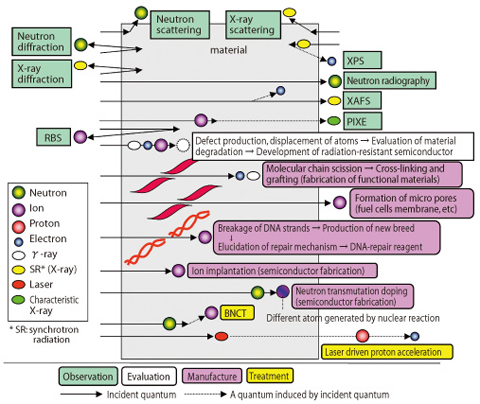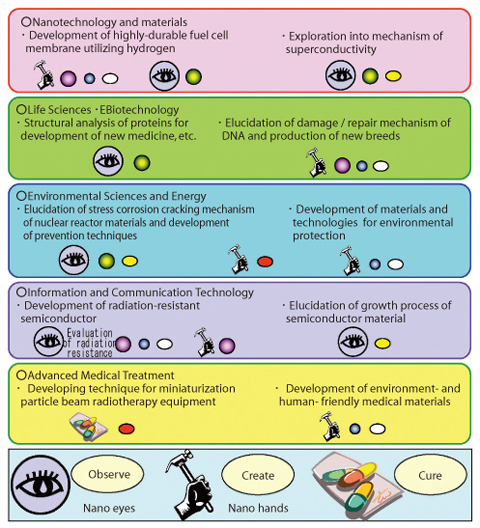Fig.4-1 Quantum beam facilities in JAEA

Fig.4-2 Interactions between quantum beam and material, and their applications

Fig.4-3 Contribution of quantum beam technology to "prioritized" areas
Fig.4-4 Aerial view of J-PARC under construction and schematics of
two experimental instruments to be established at the Material and Life Science Facility
We are carrying out research and development of "Quantum Beam Technology" utilizing the intrinsic characteristics of neutrons from reactors, ion particles and electrons from accelerators, γ-rays from radioisotopes, intense ultra-short pulsed lasers from table-top high power laser equipment and synchrotron radiation from SPring-8 (Fig.4-1).
These quantum beams have wave-particle duality. As waves, the wavelengths of these quanta are a nano-meter or less, depending on the beam energy. Consequently, one quantum acts on a part of matter of similar size at one time. Since the distance between an atom and the neighboring one in matter is also a nano-meter or less, the quantum beams make it possible to observe atomic arrangement and electronic state, and to identify elements in matter. They can also be used for ultra-fine manufacturing and special chemical reaction initiation, by cutting the bond between atoms i.e. molecular chain scission (Fig.4-2).
Hence the quantum beams become a powerful tool to "observe" with "nano eyes" and "create" with "nano hands" . By making full use of the quantum beams' characteristics, we have been promoting research and development focusing on key issues: 'life sciences', 'information and communication technology', 'environmental sciences' and 'nanotechnology and materials' in 'Four Priority Fields to be Promoted', and 'energy' in 'Four Fields to be Promoted', as described in 'The 3rd Science and Technology Basic Plan'(Fig.4-3).
In addition to the above areas, proton and heavy particle irradiation have been developed as a cancer therapy 'without scalpel' in Japan. We have carried out fundamental research starting from the fact that protons can be accelerated by the localized huge electric field induced by an intense ultra-short pulsed laser bombardment onto material. The application of this technique is expected to reduce the size and the cost of the medical treatment machines (Fig.4-2, Fig.4-3).
Among the above quantum beams, expectations for the intense pulsed beams of neutrons in particular have grown, stimulating the construction of new facilities worldwide. We have been constructing "J-PARC", the Japan Proton Accelerator Research Complex in cooperation with the High Energy Accelerator Research Organization, aiming at the commencement of operation in fiscal 2008, and has been producing neutron experiment equipment used at "J-PARC"(Fig.4-4). The facilities are expected to produce neutrons and other secondary particles of very high intensities leading the world, by proton bombardment onto a target. The objective of this project is the utilization of these particles for a variety of areas in science and technology from materials science, life science and particle physics to industrial applications. The completion of the facilities will open new prospects for advanced applications of quantum beams like neutrons.